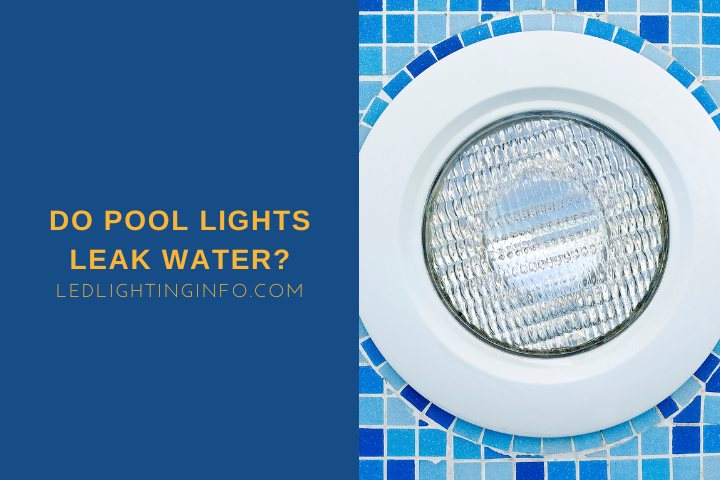Water can be a tricky customer – it has a habit of causing all kinds of problems, and when you’re dealing with a swimming pool, you’re dealing with a lot of water.
If you have swimming pool lights, there are a few different ways the water can cause issues, including leaks.
There are two types of leaks that can occur with pool lights – water can leak into the light, which damages the light, or leak out of the pool via the conduit, lowering the pool level significantly. Both issues are repairable.
In this article, I’m going to explain the different types of leaks that can occur with pool lights, including:
- Whether water in your pool lights is dangerous
- How to check whether your pool is leaking
- How to seal your pool lights
- How to fix a leak through the conduit
Is Water In Pool Lights Dangerous?
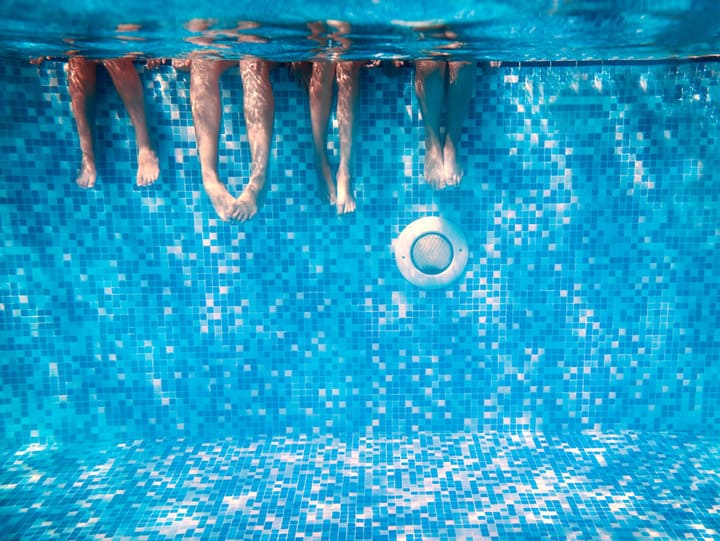
Pool lights are designed to be installed below the water level and so obviously are sealed to prevent water from getting into the fixture.
But sometimes those seals can fail, and you might notice that your light fixture has water.
It could be a small amount, or if you’ve not noticed the leak in a long time, it could have a considerable amount of water sloshing inside.
That’s not good – but how ‘dangerous’ it is, depends on the type of light.
If it’s an older pool light running on mains voltage, it’s pretty dangerous.
You’ve got a live current of 120 volts and some water inside the fixture, which could conduct that current, which is sufficient to electrocute you.
In theory, it should be protected by a ground fault circuit interrupter (GFCI) which should trip.
If your lights are more modern low voltage lights connected to a transformer, the ‘danger’ to yourself is much lower.
You can still get a shock, but it’s unlikely to kill you.
Either way, the water can absolutely damage the light, so whether or not it’s a danger to you, you still need to fix the issue before it completely breaks the light, which means resealing the light to protect it.
How To Seal Pool Lights?
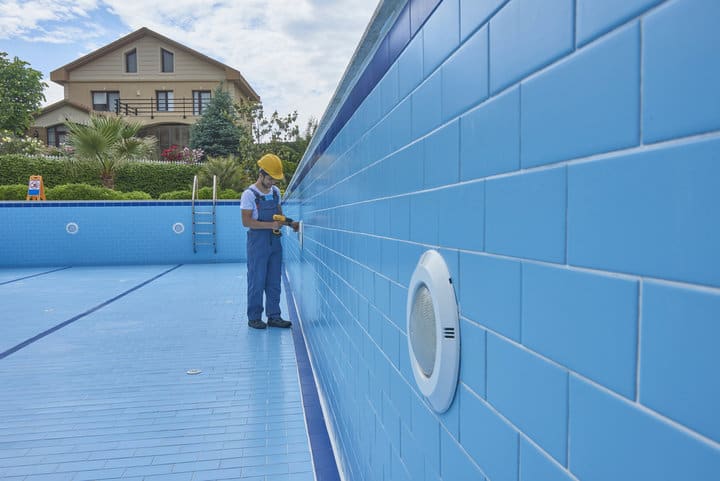
To reseal a pool light, you need to replace the gasket.
Most pool lights have a replaceable gasket, whether they have replaceable bulbs or sealed LED lights installed in a larger housing.
The gasket is the ring that acts as a seal to prevent water from getting into the fixture, and good ones tend to last 5-10 years.
Chlorine will ultimately wear away at the gasket, causing it to fail.
You should replace the gasket whenever you change the light bulb in your pool lights.
With LED lights, you will probably find that the gasket fails before the light does, so you may need to replace the gasket before changing the light.
The first step is to switch off the power to the lights, remove the light from the housing, and pull it out of the pool.
If installed correctly, there should be enough cable behind the light to let you pull it out of the water without disconnecting anything.
Once it is out of the water, unscrew the clip holding the cover and drain the light of any water that has got into the fixture.
You then want to let it dry out completely.
Remove the old gasket and put the new one in place before you reattach the light cover and make sure it’s screwed in.
Once that’s done, hold the pool light under the water.
If you notice any bubbles escaping from the light, that tells you the gasket hasn’t been installed correctly. Remove it and check for errors.
You can safely reinstall the light in the housing if there are no bubbles.
How To Test Pool Lights For Leaks?
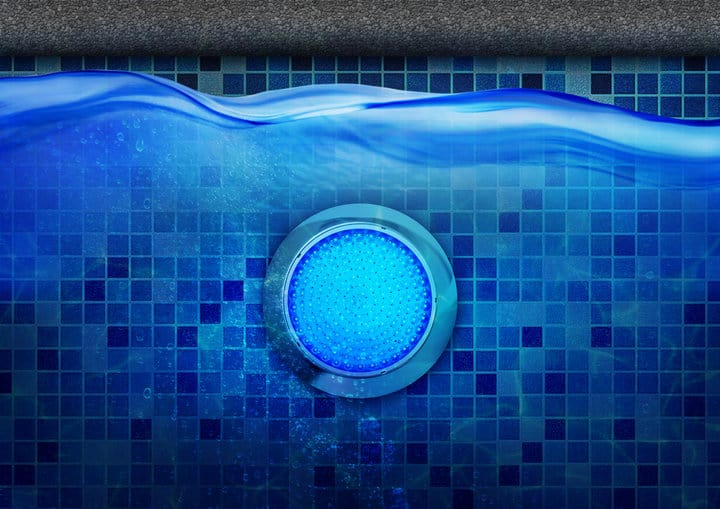
The second type of leak we could be talking about with pool lights is where your pool is leaking water via the light fixtures – causing the water levels in your pool to drop.
This is a problem, not just because your pool is dropping to levels below where you want it.
There are other issues this can cause too:
- Pool lights are designed to be submerged at all times because water transfers heat away. If your pool is leaking and the water level is dropping, your lights may end up exposed to the air and could fail
- Water leaking via the conduit can later freeze, especially if you don’t drain your pool in winter, causing the conduit to crack and potentially breaking your lights/risking electrocution
By looking at the pool level, you can check whether the pool is leaking via the lights.
If it has dropped to anywhere between the top of the light and the halfway point of the light, it’s likely a conduit leak.
If it drops below the halfway point of your lights, you have a leak elsewhere in your pool.
You might still have a conduit leak, but you should identify the other leak source first.
How To Fix A Pool Light Conduit Leak?
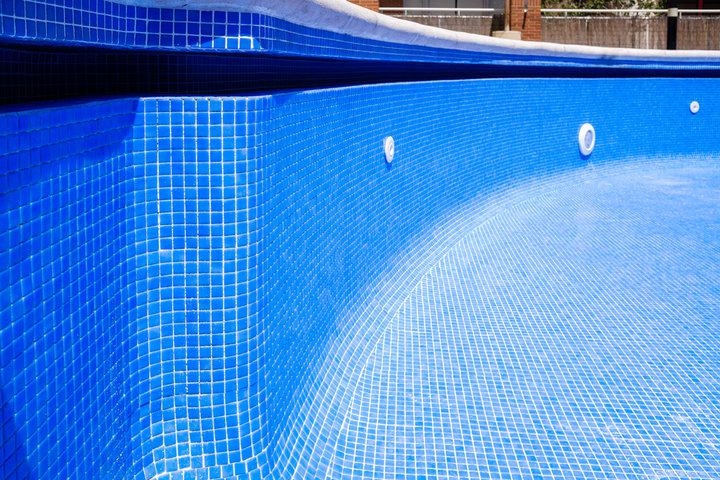
If you’ve established that your pool light conduit is leaking water, there are a few different fixes you could go for.
You can use regular sealant/putty like you would use to seal a bathroom.
To do this, drain the pool below the conduit level before applying the sealant.
The downside to sealant is that, once it dries, it’s harder to remove, and it’s not always the easiest to work with.
If you need to remove the light later, you’ll need to chip away at the sealant to break it down and re-apply it.
Another option is butyl tape.
This one has the same issue. Again, you’ll need to apply new tape if you need to pull out the cord from the conduit, but you don’t need to drain the pool to use it.
Just wrap the butyl tape around the cable, and then use a tool like a screwdriver to push it into the conduit hole to create that seal.
It’s really sticky, so it can be tricky, but it’s a relatively simple solution.
Take a look below:
Finally, you can use a pool light cord stopper.
These tight rubber seals are designed to perfectly fit your cable and act as a plug for the conduit.
They have a slit, so you can peel them open to fit them around the cable and then push them tightly into the hole.
Make sure the thinner end goes into the hole, and you push it very securely in place – that’ll create the tightest seal.
They come in two sizes to fit either ¾-inch or 1-inch conduit, so check your light manual to see which size you need.
If you aren’t sure, they’re cheap enough to justify buying both – it’s better to spend a few dollars now to prevent breaking your expensive lights in the future.
Final Words
Whether you have a leak in your pool lights or your whole pool leaks via the light conduit, you don’t want to ignore the problem.
The good news is that it’s always a relatively cheap and simple fix – either the gasket on the light needs swapping out, or you can seal the conduit using inexpensive materials.
Have you dealt with leaking pool lights or a pool in general? How did you decide to fix it?

